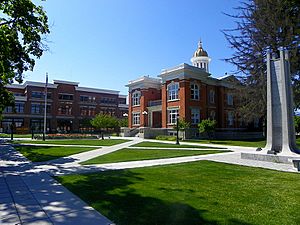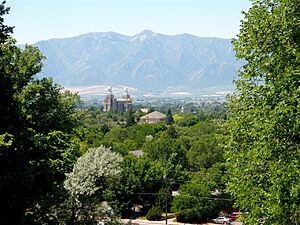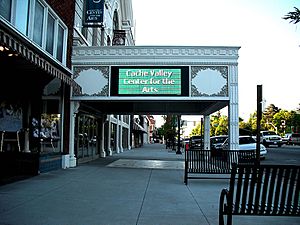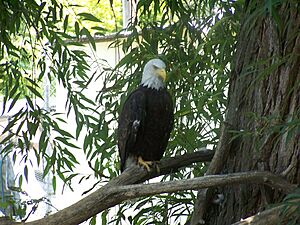Logan, Utah facts for kids
Quick facts for kids
Logan
|
|
|---|---|
|
City
|
|

Downtown Logan, with courthouse
|
|
| Motto(s):
"United in Service"
|
|

Location in Cache County and the state of Utah
|
|
| Country | |
| State | |
| County | Cache |
| Founded | 1859 |
| Incorporated | January 17, 1866 |
| Named for | Ephraim Logan |
| Government | |
| • Type | Mayor-council |
| Area | |
| • Total | 18.43 sq mi (47.74 km2) |
| • Land | 17.84 sq mi (46.22 km2) |
| • Water | 0.59 sq mi (1.52 km2) |
| Elevation | 4,534 ft (1,382 m) |
| Population
(2020)
|
|
| • Total | 52,778 |
| • Density | 2,957.5/sq mi (1,141.89/km2) |
| Time zone | UTC−7 (Mountain (MST)) |
| • Summer (DST) | UTC−6 (MDT) |
| ZIP Codes |
84321-84323, 84341
|
| Area code | 435 |
| FIPS code | 49-45860 |
| GNIS ID | 2410856 |
Logan is a city in Cache County, Utah, United States. It is the main city of the Logan metropolitan area, which includes Cache County and Franklin County, Idaho. In 2020, about 52,778 people lived in Logan. The larger Logan metropolitan area had 147,908 people. Logan is also home to the main campus of Utah State University.
Contents
History of Logan
The city of Logan was started in 1859. Brigham Young sent settlers to find a good spot for a fort near the Logan River. They named the new community "Logan" after Ephraim Logan, an early fur trapper.
Logan officially became a city on January 17, 1866. Two important colleges were founded here: Brigham Young College in 1877 (which closed in 1926) and Utah State University in 1888. Utah State University was first called the Agricultural College of Utah.
Logan has grown a lot over the years. By the mid-1960s, about 20,000 people lived there. By 2015, the population was more than 50,000.
Geography and Landscape
Logan is in northern Utah, about 47 miles (76 km) north of Ogden. It is also about 82 miles (132 km) north of Salt Lake City. The city sits near the eastern edge of Cache Valley, on the western slopes of the Bear River Mountains.

The city covers about 18.43 square miles (47.74 square kilometers). Most of this area is land, with a small part being water. Mount Logan, a tall mountain, is just to the east of the city.
The eastern parts of Logan are built on "benches." These are flat, shelf-like areas made from ancient river deposits. These deposits formed when the Logan River flowed into a large, ancient lake called Lake Bonneville. Over thousands of years, the river built up a big delta. Later, when Lake Bonneville drained, the Logan River cut through these deposits. This created the steep slopes and low-lying areas you see today. To the west of Logan, there are flat farmlands and marsh areas.
Logan's Climate
Logan has a climate with warm, often dry summers and cold winters. It usually snows a moderate amount in winter. Spring months tend to have the most rain.
Sometimes in winter, a weather pattern called a "temperature inversion" happens. This traps cold air and pollution in the valley. It can make the air quality unhealthy for a few days.
| Climate data for Logan, Utah (Utah State University), 1991–2020 normals, extremes 1893–present | |||||||||||||
|---|---|---|---|---|---|---|---|---|---|---|---|---|---|
| Month | Jan | Feb | Mar | Apr | May | Jun | Jul | Aug | Sep | Oct | Nov | Dec | Year |
| Record high °F (°C) | 60 (16) |
64 (18) |
75 (24) |
86 (30) |
94 (34) |
99 (37) |
103 (39) |
101 (38) |
98 (37) |
89 (32) |
74 (23) |
66 (19) |
103 (39) |
| Mean maximum °F (°C) | 47.8 (8.8) |
52.5 (11.4) |
65.6 (18.7) |
75.8 (24.3) |
83.5 (28.6) |
91.5 (33.1) |
96.8 (36.0) |
95.2 (35.1) |
89.3 (31.8) |
78.7 (25.9) |
62.7 (17.1) |
51.9 (11.1) |
97.3 (36.3) |
| Mean daily maximum °F (°C) | 32.2 (0.1) |
36.9 (2.7) |
48.2 (9.0) |
56.5 (13.6) |
66.8 (19.3) |
77.9 (25.5) |
88.2 (31.2) |
86.6 (30.3) |
75.6 (24.2) |
60.7 (15.9) |
45.3 (7.4) |
33.6 (0.9) |
59.0 (15.0) |
| Daily mean °F (°C) | 24.9 (−3.9) |
29.0 (−1.7) |
39.0 (3.9) |
46.3 (7.9) |
55.6 (13.1) |
64.9 (18.3) |
74.2 (23.4) |
72.8 (22.7) |
62.8 (17.1) |
49.7 (9.8) |
36.9 (2.7) |
26.3 (−3.2) |
48.5 (9.2) |
| Mean daily minimum °F (°C) | 17.6 (−8.0) |
21.1 (−6.1) |
29.8 (−1.2) |
36.0 (2.2) |
44.4 (6.9) |
51.9 (11.1) |
60.2 (15.7) |
58.9 (14.9) |
50.0 (10.0) |
38.7 (3.7) |
28.5 (−1.9) |
18.9 (−7.3) |
38.0 (3.3) |
| Mean minimum °F (°C) | 1.9 (−16.7) |
6.5 (−14.2) |
15.7 (−9.1) |
25.2 (−3.8) |
32.7 (0.4) |
39.8 (4.3) |
51.2 (10.7) |
49.2 (9.6) |
37.4 (3.0) |
25.6 (−3.6) |
12.7 (−10.7) |
2.9 (−16.2) |
−1.9 (−18.8) |
| Record low °F (°C) | −23 (−31) |
−23 (−31) |
−6 (−21) |
9 (−13) |
16 (−9) |
28 (−2) |
36 (2) |
35 (2) |
24 (−4) |
3 (−16) |
−16 (−27) |
−25 (−32) |
−25 (−32) |
| Average precipitation inches (mm) | 1.83 (46) |
1.61 (41) |
2.17 (55) |
2.26 (57) |
2.41 (61) |
1.27 (32) |
0.57 (14) |
0.71 (18) |
1.34 (34) |
1.83 (46) |
1.38 (35) |
1.59 (40) |
18.97 (479) |
| Average snowfall inches (cm) | 12.9 (33) |
12.2 (31) |
8.5 (22) |
4.1 (10) |
0.3 (0.76) |
0.0 (0.0) |
0.0 (0.0) |
0.0 (0.0) |
0.0 (0.0) |
1.4 (3.6) |
6.3 (16) |
15.8 (40) |
61.5 (156.36) |
| Average extreme snow depth inches (cm) | 10.2 (26) |
10.1 (26) |
6.3 (16) |
2.5 (6.4) |
0.3 (0.76) |
0.0 (0.0) |
0.0 (0.0) |
0.0 (0.0) |
0.0 (0.0) |
1.1 (2.8) |
3.5 (8.9) |
7.8 (20) |
12.8 (33) |
| Average precipitation days (≥ 0.01 in) | 10.5 | 9.8 | 9.4 | 10.4 | 11.3 | 5.8 | 4.0 | 5.3 | 5.7 | 7.9 | 8.1 | 10.9 | 99.1 |
| Average snowy days (≥ 0.1 in) | 8.6 | 6.4 | 4.1 | 1.9 | 0.3 | 0.0 | 0.0 | 0.0 | 0.0 | 0.7 | 3.8 | 8.5 | 34.3 |
| Source 1: NOAA | |||||||||||||
| Source 2: National Weather Service | |||||||||||||
People of Logan
| Historical population | |||
|---|---|---|---|
| Census | Pop. | %± | |
| 1870 | 1,757 | — | |
| 1880 | 3,396 | 93.3% | |
| 1890 | 4,565 | 34.4% | |
| 1900 | 5,451 | 19.4% | |
| 1910 | 7,522 | 38.0% | |
| 1920 | 9,439 | 25.5% | |
| 1930 | 9,979 | 5.7% | |
| 1940 | 11,868 | 18.9% | |
| 1950 | 16,832 | 41.8% | |
| 1960 | 18,731 | 11.3% | |
| 1970 | 22,333 | 19.2% | |
| 1980 | 26,844 | 20.2% | |
| 1990 | 32,762 | 22.0% | |
| 2000 | 42,670 | 30.2% | |
| 2010 | 48,174 | 12.9% | |
| 2020 | 52,778 | 9.6% | |
| 2023 (est.) | 55,250 | 14.7% | |
| source: | |||
In 2020, Logan had 52,778 people. The city's population has grown steadily over the years. In 2010, about 83.9% of the people were White. Other groups included African American, Native American, Asian, and Pacific Islander. About 13.9% of the population was Hispanic or Latino.
In 2000, about 23.4% of Logan's population was under 18 years old. The median age was 24 years. This means half the people were younger than 24, and half were older.
Logan's Economy
Logan has many different types of businesses and jobs. Key areas include education, making products, medical services, farming, and retail stores.
The biggest employer in Logan is Utah State University and its Space Dynamics Laboratory. Other major employers include companies like ICON Health & Fitness, Campbell Scientific, and various hospitals and school districts.
Companies Based in Logan
Several companies and organizations have their main offices in Logan:
- Utah State University – a large university.
- Al’s Sporting Goods – a chain of sports stores.
- Gossner Foods – a company that makes dairy products.
- Ifrogz – a company that makes cases for Apple products.
- Infinite Discs – a company for disc golf equipment.
- Lee’s Marketplace – a chain of grocery stores.
- Space Dynamics Lab – an aerospace and government contractor.
- S&S Worldwide – a company that makes amusement park rides.
- Utah Festival Opera – an opera company.
Arts and Culture in Logan
Logan offers many fun attractions and events for everyone.
- Utah Festival Opera & Musical Theatre hosts amazing shows.
- The Ellen Eccles Theatre is a historic place for performances.
- The Summerfest Arts Faire features local art, music, food, and activities for kids.
- The Cache Valley Cruise-In is Utah's largest car event, with cool vehicles, concerts, and a car parade.
- The LGBTQA Pride festival started in 2016.
- The Logan Utah Temple is a beautiful historic building completed in 1884.
Parks and Recreation
Logan has a great Parks and Recreation department. They manage several places for outdoor fun.
- The Logan River Golf Course and Logan Golf and Country Club are two places to play golf.
- Zootah at Willow Park is a small zoo with animals like monkeys, coyotes, bobcats, and bald eagles.
- The Logan/Cache County Fairgrounds hosts events like fairs, rodeos, and demolition derbies.
- The city also has an aquatic center for swimming and a skate park.
- In winter, you can go ice skating at Merlin Olsen Park.
Education in Logan
Logan has two public school districts: Logan City School District and Cache County School District.
- The Logan City School District has six elementary schools, one middle school, and Logan High School.
- The Cache County School District has high schools outside Logan in other cities.
There are also special schools called charter schools:
- Edith Bowen Laboratory School (K-6th grade) is on the Utah State University campus.
- Bear River Charter School (K-6th grade).
- Fast Forward Charter High School.
- InTech Collegiate Academy is a high school focused on science, technology, engineering, and math (STEM). It works with Utah State University.
Colleges and Universities
- Bridgerland Technical College offers programs to help students get job skills.
- Utah State University offers many different degrees, from bachelor's to doctoral degrees.
Media and News
Logan has several ways to get news and entertainment.
Newspapers
- The Herald Journal is a daily newspaper.
- Cache Valley Daily is a news website run by KVNU radio.
- The Utah Statesman is a student newspaper at Utah State University.
Television
- KUTA-TV 8 is a local TV station.
- The Valley Channel provides community-focused programs.
Radio
- Utah Public Radio is a National Public Radio station on the Utah State University campus.
- KVNU offers news, sports, and talk shows.
- KBLQ plays soft rock music.
- KVFX plays Top 40 music.
Transportation in Logan
Getting around Logan is easy with different transportation options.
- Many people in Logan bike to work. In 2009, Logan was one of the top cities in the U.S. for bicycle commuters.
Highways
- US-89
- US-91
Bus System
Logan has a free bus system called the Cache Valley Transit District (CVTD). It started in 1992 and expanded in 2007.
- It has 16 routes that serve Logan and nearby cities like North Logan and River Heights.
- Some routes go as far north as Richmond and as far south as Hyrum.
- There is also a bus that connects to Lewiston and Preston, Idaho five times a day.
Air Travel
The Logan-Cache Airport is a public airport for small planes. It offers flight lessons and private charter flights.
Famous People from Logan
- Jawahir Ahmed, a model and beauty pageant winner.
- Neil L. Andersen, a leader in the LDS Church.
- Rocky Anderson, a former mayor of Salt Lake City.
- Michael Ballam, an opera singer.
- Elaine Bradley, a member of the band Neon Trees.
- Hugh B. Brown, a military officer and politician.
- Reed Budge, an Idaho politician.
- Charles Bullen, a politician.
- Shay Carl, an internet celebrity.
- Ron Carlson, a novelist.
- Quentin L. Cook, a leader in the LDS Church.
- Chris Cooley, a football player for the Washington Redskins.
- Kevin Curtis, an NFL football player.
- Marriner Eccles, a former chairman of the Federal Reserve Bank.
- Luke Falk, a football player.
- Rulon Gardner, an Olympic gold medalist in wrestling.
- Hal Garner, a football player for the Buffalo Bills.
- John Gilbert, a silent film star.
- Kenny Griffin, an Olympic gymnast.
- Morris R. Jeppson, a weapons test officer on the Enola Gay.
- Robert M. Kimmitt, a former government official and ambassador.
- Russell Maughan, a pioneer aviator who flew across America in one day.
- Joseph M. Newman, a film director.
- Chase Nielsen, a member of the Doolittle Raid.
- Merlin Olsen, a football player, actor, and TV personality.
- L. Tom Perry, a leader in the LDS Church.
- Casey Robinson, a screenwriter and film producer.
- Lenore Romney, former First Lady of Michigan.
- May Swenson, a poet.
- Jean Sullivan, an actress.
- Kip Thorne, an astronomer and physicist who won a Nobel Prize.
- John W. Welch, a scholar of law and religion.
- Larry Winborg, an illustrator.
- Evelyn Wood, known for speed-reading.
See also
 In Spanish: Logan (Utah) para niños
In Spanish: Logan (Utah) para niños





